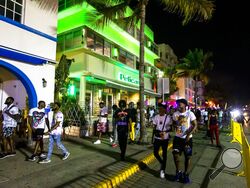MIAMI BEACH, Fla. (AP) — Miami Beach officials have spent recent years trying to control the raucous crowds, public drinking and growing violence associated with the city's world-famous South Beach neighborhood during spring break.
Business owners claim they're being unfairly targeted by regulations, and civil rights advocates say the city is trying to scare away Black tourists who make up many of the visitors.
Two shootings that wounded five people last weekend, prompting the city to impose an emergency midnight curfew this weekend, have refocused attention on the glamorous waterfront's future — as an entertainment district or something else entirely. The city's mayor, a Democrat, insists the crackdown is about bad behavior, not race.
The 10-block stretch of Ocean Drive known for art deco hotels, restaurants and bars lies between areas that cater to more affluent tourists, as well as locals. Many longtime residents have learned to treat spring break like a hurricane: Stay inside and hunker down until it's over.
Resident Pedro Herrera, 40, said spring break is great for business at the hotel where he works, but he stays away from tourist areas when he's off the clock.
“Before spring break, you can go walk on Ocean Drive,” Herrera said. “Right now, I prefer to stay home, because I know if I go there, something is going to happen.”
Mayor Dan Gelber said spring break and several holiday weekends throughout the year have been a problem for the city since before he took office in 2017. He sees the long-term solution as a fundamental change in the area around Ocean Drive from an entertainment district to a cultural district, replacing all-night bars and clubs with residential development and boutique offices.
“We don’t need an entertainment-only district,” Gelber said.
Developed in the 1920s and 1930s, Ocean Drive serves as the center of the Miami Art Deco District, including hundreds of buildings featuring the style’s signature bold geometry and intense colors. The area fell into disrepair but enjoyed a cultural and economic renaissance thanks to television shows like “Miami Vice” in the 1980s and fashion designer Gianni Versace moving into an oceanfront mansion in the 1990s. Bars and nightclubs flourished as South Beach became a destination for supermodels, musicians and other entertainers.
“Now, we have this business model of big drinks and large volumes all night long with tens of thousands of people,” Gelber said. “Which really just doesn’t work for our city.”
Gelber said he is still pursing a 2 a.m. South Beach alcohol ban, which was blocked by a circuit court judge earlier this month. Last call is 5 a.m. throughout most of Miami Beach, and South Beach businesses have been pushing back against the proposed rule that targets only their part of town.
The legendary Clevelander hotel and bar on Ocean Drive sued the city over the alcohol rollback last spring. Though not part of the lawsuit, Joshua Wallack, chief operating officer of nearby Mango’s Tropical Cafe, said the proposed rules give bars and clubs outside the target area an unfair advantage and threaten businesses inside the area with possible closure.
“They are pushing for a 2 a.m. ban but with exemptions,” Wallack said. “Do you really think they want to shut down the Fontainebleau?”
The Fontainebleau Miami Beach is an iconic luxury hotel more than a mile north of the South Beach area. The hotel's nightclub, LIV, regularly stays open until 5 a.m.
Some civil rights advocates believe city officials are concerned about the demographics of the visitors. South Beach started to become a popular destination for Black tourists about two decades ago as promoters organized Urban Beach Week during the Memorial Day weekend. Many locals have complained about violence and other crime associated with the event, which led to an increased police presence. But the event's continued popularity correlates to a bump in Black tourism throughout the year, including spring break.
Stephen Hunter Johnson, an attorney and member of Miami-Dade’s Black Affairs Advisory Board, said the emergency curfew was an overreaction to last weekend's shootings. He argued that if two nonfatal shootings in two days was enough to warrant a state of emergency, then the entire county should be under a state of emergency indefinitely.
“The only emergency in Miami Beach is that there were Black people there,” Johnson said.
More than 1,000 people were arrested last March, when the city imposed an 8 p.m. curfew. At the time, authorities sent military style vehicles to disperse predominantly Black crowds with rubber bullets, prompting criticism from Black activists. In an attempt to discourage large crowds, the city had canceled all programs amid the pandemic, leaving a void for tens of thousands of people gathered with nothing to do.
Johnson said this year's Miami Beach Live concert series, the city's attempt to return programming to spring break, completely ignored the young urban demographic by booking artists like 1990s alt-rocker Alanis Morissette and Broadway performer Bernadette Peters.
Miami Beach's mayor rejects the idea that the city is somehow trying to discourage Black visitors.
“The issue this weekend was obviously related to behavior and not race,” Gelber said. “We had spring break for three weeks without asking for a curfew, without invoking the emergency powers. We did it the morning after two shootings.”
Many visitors feel it's unfair to be surprised with restrictions after making their spring break plans weeks or months in advance, but most are still determined to have a good time.
Anwar Hassan, 21, visiting from Washington, D.C., said he'll just find something else to do after the curfew.
“I'm not going to let this limit my trip," Hassan said. "I'll just go do something else somewhere else. It doesn't have to be at the beach. This place is huge. We’ll find something.”

